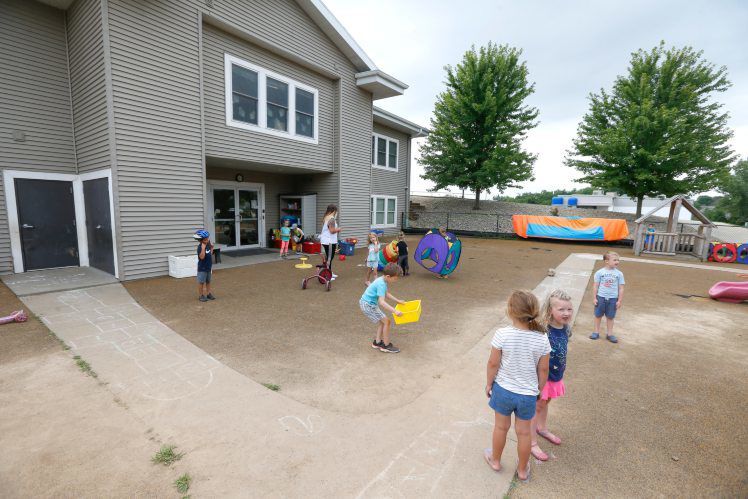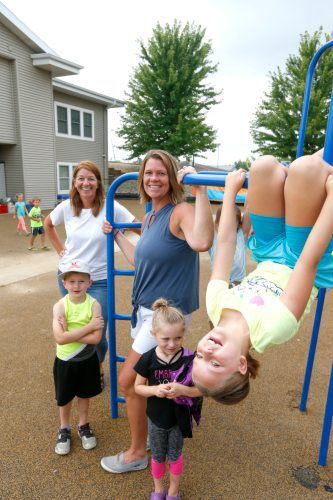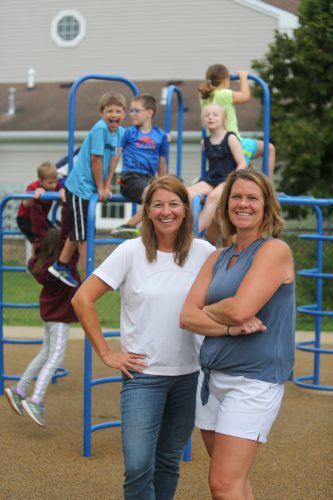Many Iowa parents with newborns, preschool and elementary school-aged children have had to find alternatives for child care or stay out of the workforce because of a shortage of child care providers throughout the state.
Sometimes child care providers have closed down and those that remain have problems finding quality employees. Now, with the COVID-19 pandemic, the child care provider shortage has become even more severe.
Provider decline
Statistics from the Iowa-based Child Care Resource and Referral show the child care provider decline in the Dubuque area began in 2006.
“There’s nothing to pinpoint exactly what started the decline,” said Tara Roddick, child care consultant supervisor for the group. “Some situations that contribute to providers closing are the economy, lack of health insurance for employees and higher pay at another employer.”
Roddick shared statistics from July 2018 to June 2020 showing the totals of Dubuque child care providers that have closed, the number that have been added and the total capacity of Dubuque child care providers.
CCR&R supports quality child care throughout Iowa. CCR&R child care consultants provide on-site consultation to providers. The Iowa Department of Human Services (DHS) is the regulatory agency for early childhood care and education. CCR&R supports providers in complying with state regulations. Training is offered to providers to meet licensing and registration requirements and improve the quality of care.
Waiting Lists
“We have an extensive waiting list for children, birth and up. At this time, it could take one to three years depending on the age of the child to get into our program,” said Barb Weber, co-director of Young-Uns Preschool and Child Care Center.
Young-Uns accepts children from birth to 12-years-old. It offers preschool for 3- to 5-year-olds, transportation, before and after school care for kindergarten-fifth grade and child care for infants and older. They are licensed for 237 children and have 265 enrolled.
In addition to a licensing fee, providers pay a capacity fee based on the amount of usable space at the facility divided by the enrollment capacity at any one time which is currently 75 square feet per child. The usable space is determined by the licensing consultant. Some of the children enrolled at Young-uns don’t attend every day. This allows the facility to have more children enrolled than what they are licensed for as the facility doesn’t exceed their capacity limit.
Regulations costly, ensure child safety
Before a provider can hire someone, the prospective employee is subject to background checks that include the National Crime Information Center and National Sex Offender Registry Check and the Child Abuse/Neglect registry.
Weber said, “Child care is a highly regulated profession which also makes it very expensive to hire good quality employees. Providers typically have a lack of benefits and pay low wages to their employees. Once an employee is hired, it can typically take six months to fully train and complete all of the state requirements. We currently pay for employees to complete a records check and fingerprints. We also are required to have every employee complete numerous continuing education classes before they can even step foot in a classroom.”
Weber said the general cost to hire is between $650-$1,000 per employee.
“It would be great if we had more state funding to help reduce the cost of hiring employees. It would also be nice to have monetary assistance to offer a benefit package to retain our quality employees.”
As numbers of providers have declined, Roddick said it is suspected that there are increases in unregulated care.
“When this happens parents might choose programs because of their lower cost. The risk of this is that these programs typically have too many children and do not follow guidelines or best practices. Educating parents on the differences in child care environments continues to be something that CCR&R works on.”
Depending on the type of provider, employees must be a minimum of 18, 20 or 21 to work at a facility.
Providers are subject to an inspection visit by the DHS prior to registration and licensing. An annual monitoring of the facility and records inspection is completed by the DHS. CPR and first aid certification along with emergency preparedness and response planning are required.
Pandemic waiting game
The DHS reports that about 1,000 registered child care centers throughout the state closed when COVID-19 moved into Iowa. About 800 of these centers normally take between 20-100 children, the rest are child development homes that can take from eight to 16 children. Many have since reopened.
With the pandemic, parents are working from home and kids attend school online. Some parents might have pulled their preschool aged children out of child care to save money. Children who were previously attending child care full-time might be switched to part-time as parents who are working from home seek some respite.
These actions cause parents to lose their spot and lead to lower enrollment at the provider. Parents will have to search for new quality, affordable child care when it’s safe to go back to work. Providers aren’t sure if they are going to continue to struggle with low numbers of enrollment or see a surge of demand because so many other programs have closed.
Parents are waiting to hear when it’s possible to go back to work, school districts are determining if the fall 2020 school year will be online or in-person and child care providers are waiting for both state and county governments to decide. The pandemic has put everyone in a waiting game.
Pandemic safety measures
Young-Uns remained open during the spring when many providers were closed. They implemented safety measures including taking the temperature upon arrival of every child, staff greeting families at the door and taking children to the classroom instead of parents taking their children to the classroom.
“We clock the children in and out in order to avoid multiple touches on our computer check-in system and we sanitize each child’s hands upon arrival. When the child arrives in the classroom, they wash their hands in the classroom washing sinks,” Weber said.
In March, all Young-Uns classroom floors were stripped and sanitized. Classrooms received new rugs. Family-style meals were eliminated and replaced by plated meals. Deep cleaning is done frequently and an I-Wave air purifying system was installed in all of the furnaces, which helps control viruses, germs, allergens and odors.
The DHS and CCR&R work together to get needed and hard-to-find supplies to providers, including hand sanitizer, thermometers, bleach, toilet paper, gloves and masks. Providers have found obtaining these items challenging, since they can’t get to stores at opening time when these items might be available.
State and federal government response
Providers say they need support and financial aid from the state and federal governments in order to survive the pandemic and continue to function beyond.
In early March, pre-pandemic, the Iowa House passed five bills with a goal to ease the child care provider shortage. One of the bills (House File 2600) creates a state matching grant program allowing communities to access state grant money if they provide money for the child care WAGE$ Iowa program or other child care workforce strategies. A second bill (House File 2770) raises the state reimbursement rate under the state child care assistance program.
Dubuque County Early Childhood, a local nonprofit receives state allocations, grants and donations to implement early childhood programs and services in Dubuque County based on community needs. More than 5,000 children either receive assistance or are impacted in some way by the group’s services.
Abigail Degenhardt, director of DCEC shared that the organization requested and was granted $60,000 from the Dubuque County Board of Supervisors to begin implementing a new in-home child care provider incentive.
“We hope to have 10 new in-home providers registered this year,” Degenhardt said.
The Federal CARES Act gave aid to providers that have stayed in operation and to those that had to close due to the pandemic, but are reopening. Families using child care assistance and essential workers using child care are eligible for the CARES Act aid. The Paycheck Protection Program has helped some providers keep staff members on the payroll even if they aren’t open or working at capacity.








